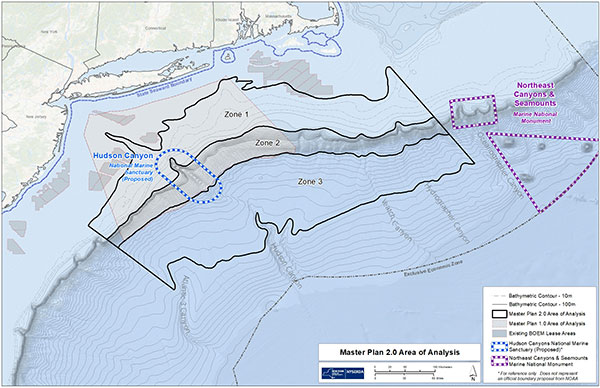Offshore Wind Master Plan
Master Plan 2.0
Governor Hochul launched the “New York State Offshore Wind Master Plan 2.0: Deep Water” (Master Plan 2.0) in 2022, to adapt and update New York’s strategies for a rapidly evolving industry, building on work presented in Master Plan 1.0. In alignment with New York’s 10-Point Action Plan, Master Plan 2.0 will provide a plan for the continued growth of offshore wind development, that will allow for the expansion of the industry and ability to meet regional needs. To support Master Plan 2.0, the State is working with stakeholders to explore new strategies for the responsible and cost-effective development of the offshore wind resource and advancing new studies that will synthesize and analyze data to identify potential areas of least-conflict and greatest-opportunity for offshore wind development within three zones considered in the Area of Analysis (AoA).
Learn more about NYSERDA spatial studies in the Area of Analysis.

Master Plan 2.0 Area of Analysis
- Zone 1 is closest to shore and includes a portion of the Outer Continental Shelf. It extends from the 60-meter contour out to the continental shelf break [60 meters (197 feet) to 150 meters (492 feet) deep]. Zone 1 is approximately 12,040 square miles.
- Zone 2 spans the steeply sloped continental shelf break, with unique canyon geology and habitats [150 meters (492 feet) to 2,000 meters (6,561 feet) deep]. Zone 2 is approximately 6,830 square miles.
- Zone 3 extends from the continental shelf break out to 3,000 meters (9,842 feet) depth. Zone 3 is approximately 16,800 square miles.
Master Plan Studies (2017-2018)
NYSERDA conducted 20 studies and engaged with stakeholders and the public to create The New York State Offshore Wind Master Plan in order to determine the most responsible and cost-effective pathways for developing offshore wind energy.
Blueprint for the New York State Offshore Wind Master Plan (2017) [PDF]
- Master Plan 1.0: Analysis of Multibeam Echo Sounder and Benthic Survey Data [PDF]
- Master Plan 1.0: Assessment of Ports and Infrastructure [PDF]
- Master Plan 1.0: Aviation and Radar Assets Study [PDF]
- Master Plan 1.0: Birds and Bats Study [PDF]
- Master Plan 1.0: Cable Landfall Permitting Study [PDF]
- Master Plan 1.0: Cables, Pipelines, and Other Infrastructure Study [PDF]
- Master Plan 1.0: Consideration of Potential Cumulative Effects [PDF]
- Master Plan 1.0: Cultural Resources Study [PDF]
- Master Plan 1.0: Environmental Sensitivity Analysis [PDF]
- Master Plan 1.0: Fish and Fisheries Study [PDF]
- Master Plan 1.0: Health and Safety Study [PDF]
- Master Plan 1.0: Marine Mammals and Sea Turtles Study [PDF]
- Master Plan 1.0: Marine Recreational Uses Study [PDF]
- Master Plan 1.0: Offshore Wind Injection Assessment [PDF]
- Master Plan 1.0: Preliminary Offshore Wind Resource Assessment [PDF]
- Master Plan 1.0: Sand and Gravel Resources Study [PDF]
- Master Plan 1.0: Shipping and Navigation Stud [PDF]
- Master Plan 1.0: U.S. Jones Act Compliant Offshore Wind Turbine Installation Vessel Study [PDF]
- Master Plan 1.0: Visibility Threshold Study [PDF]
- Master Plan 1.0: The Workforce Opportunity of Offshore Wind in New York [PDF]
- Master Plan 1.0: Area for Consideration for the Potential Locating of Offshore Wind Energy Areas (Submission to Bureau of Ocean Energy Management) [PDF]
- Master Plan 1.0: Offshore Wind Policy Options Paper [PDF]
- Master Plan 1.0:Outreach and Engagement Summary [PDF]
- Master Plan 1.0: Table of Permits and Approvals [PDF]
